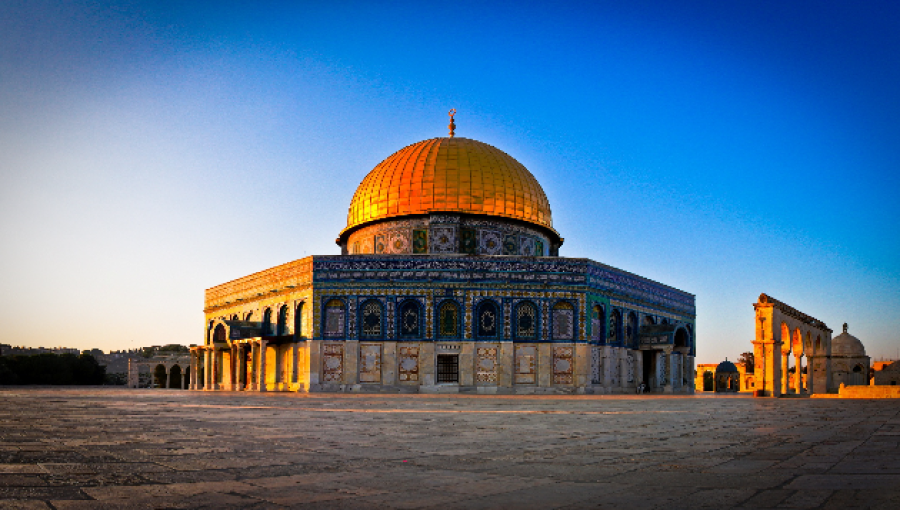In the center of Jerusalem's historic Old City stands a grand edifice that has intrigued people across the globe for generations - the Dome of the Rock. This renowned mosque bears great historical, religious, and architectural importance, acting as evidence of the diverse cultural legacy of Islam. Due to its elaborate architecture and deep religious significance, the Dome of the Rock serves as a representation of Islamic culture and the lasting impact of Muslim society. Built in the year 691 AD under the rule of the Umayyad Caliphate, this magnificent structure features a shining golden dome and unique octagonal design that symbolize a blend of Byzantine, Persian, and Islamic architectural influences. This embodies the rich cultural heritage and exceptional artistic talent of the creators behind this masterpiece. The Dome of the Rock is not just a beautiful architectural structure; it also holds significant spiritual significance for Muslims globally. It is believed to contain the rock from which the Prophet Muhammad ascended to heaven during the Night Journey. It acts as a sacred destination, where followers journey for worship, contemplation, and spiritual contemplation, attracting millions of pilgrims annually who seek comfort and communion with their beliefs. As we admire its splendor and reflect on its importance, let us pay tribute to the Dome of the Rock as a shining example of Islamic legacy and a representation of harmony and tranquility in a constantly evolving society.
Historical Context
The construction of the Dome of the Rock marked a significant chapter in the history of Jerusalem, a city steeped in religious significance long before the rise of Islam. Dating back to the reign of King David around 1000 BCE, Jerusalem became the capital of ancient Israel, with his son Solomon erecting the First Temple, a revered center of worship for the Israelites. However, this sacred site was later destroyed by the Romans in 70 CE, leading to the establishment of a Roman city, Aelia Capitolina, on its ruins.
With the advent of Christianity and the conversion of Emperor Constantine I, Jerusalem experienced a revival, evidenced by the construction of the Church of the Holy Sepulchre over the traditional site of Jesus' crucifixion and resurrection. By the 7th century, the city flourished with splendid churches and monasteries, reflecting its importance as a religious center.
The capture of Jerusalem by the second Muslim caliph, ʿUmar I, in 638 marked a turning point in its history. Despite initial struggles with civil war and instability within the nascent Islamic empire, the reign of the Umayyad caliph Abd al-Malik saw the monumental construction of the Dome of the Rock. Completed around 691-692 CE, this architectural marvel stood prominently among the city's churches, symbolizing the growing power and influence of Islam.

Over the centuries, the Dome of the Rock underwent various renovations and modifications under successive Islamic dynasties, including the Abbasids, Fatimids, and Ayyubids. These renovations added to its splendor, with each dynasty leaving its own inscriptions and ornamentations.
During the Crusader kingdom of Jerusalem, efforts were made to safeguard the rock within the Dome, reflecting the religious tensions of the time. The Ottoman sultan Süleyman I initiated a significant restoration in the 16th century, replacing exterior mosaics with colored ceramic tiles. In the 20th century, further restoration work was undertaken, preserving the Dome's interior and exterior ornaments, including the application of a new gold covering to its dome.
Through centuries of change and upheaval, the Dome of the Rock has remained a symbol of Jerusalem's enduring religious significance, reflecting the diverse cultural and religious heritage of the city.
Architectural Splendor
The Dome of the Rock, situated atop the elevated plaza known as al-Ḥaram al-Sharīf to Muslims and as the Temple Mount to Jews, stands as a marvel of architectural and religious significance. Rooted in the Byzantine architectural tradition yet embodying the emerging Islamic visual style of the 7th century, its design reflects a fusion of cultural influences that have shaped its enduring legacy.
The structure, positioned at the center of a wide raised platform, features an octagonal base topped by a gilded wooden central dome, approximately 65 feet (20 meters) in diameter. Supported by a circle of 16 piers and columns, the dome rises above an octagonal arcade of 24 piers and columns. Below the dome lies a portion of the sacred rock, believed by Muslims to be the spot from which the Prophet Muhammad ascended to heaven during the Night Journey (Isra and Mi'raj), protected by a railing. A stairway leads to a natural cave beneath the surface of the rock. The outer walls, forming an octagon, are adorned with many windows and rise approximately 36 feet (11 meters) high.
Both the interior and exterior of the Dome of the Rock are adorned with marble, mosaics, and metal plaques. The mosaics, reminiscent of Byzantine craftsmanship, eschew representations of human or animal forms in favor of Arabic script and vegetal patterns interspersed with images of jewels and crowns. Arabic religious inscriptions encircle the octagonal arcade, adding to the structure's spiritual significance.

The Dome's design reflects the artistic and cultural exchanges of its time, drawing inspiration from nearby Byzantine churches and palaces. Despite alterations during the Ottoman period and in modern times, including the addition of a gold-plated roof, its octagonal structure and distinctive blend of Byzantine, Persian, and Umayyad styles endure as a testament to the ingenuity and craftsmanship of its builders.
Read: The Great Mosque of Cordoba
As a symbol of Jerusalem's religious heritage and a sacred site for Muslims around the world, the Dome of the Rock continues to inspire awe and reverence, its architectural grandeur serving as a reminder of the enduring legacy of Islamic civilization.
Religious Significance
The Dome of the Rock stands as a beacon of spiritual significance for Muslims worldwide, revered as the spot from which the Prophet Muhammad ascended to heaven during the Night Journey. This belief imbues the site with profound importance, making it the third holiest site in Islam, following only the Kaaba in Mecca and the Prophet's Mosque in Medina. Each year, millions of pilgrims journey to the Dome of the Rock, drawn by a desire to pay homage and find solace in its sacred atmosphere.

However, beyond its religious significance, the Dome of the Rock holds a deeper cultural resonance, serving as a testament to Islamic heritage and identity. Its breathtaking mosaics, adorned with verses from the Quran and intricate geometric patterns, stand as a testament to the artistic brilliance of Islamic civilization. Through the centuries, this monument has not only been a place of worship but also a source of inspiration for poets, artists, and scholars alike, leaving an indelible mark on Islamic art and architecture.
In essence, the Dome of the Rock transcends its physical form to become a symbol of the rich tapestry of Islamic culture and heritage, inspiring awe and reverence in all who behold its magnificence.
Multifaceted Role in Muslim Society
The Dome of the Rock, while primarily revered in Islam for its association with the Prophet Muhammad's ascent to heaven, holds a complex and multifaceted significance that extends beyond its religious connotations. Despite lacking explicit inscriptions referencing the event, its architectural design and historical context offer insights into its intended purpose and symbolism.
Constructed during the Umayyad Caliphate, the Dome of the Rock's design reflects a blend of architectural influences, possibly intended to assert Islam's connection to the Abrahamic tradition and rival the grandeur of Christian holy sites in Jerusalem. While some scholars suggest it was built as a substitute for the Kaaba in Mecca, others propose eschatological motives, aligning its design with beliefs about Judgment Day and heaven.
Beyond Islam, the Dome of the Rock holds religious significance for Judaism, situated on the Temple Mount where the ancient Temple of Jerusalem once stood. Its association with the Foundation Stone, revered in Jewish tradition, adds layers of religious complexity to its identity. Additionally, during the Crusades, it served as a church for the Knights Templar, highlighting its role in interfaith interactions throughout history.
Read: A Jewel of Ottoman Architecture and Islamic Heritage
Moreover, the Dome of the Rock stands as a symbol of Islamic cultural heritage and identity, showcasing the artistic brilliance of Muslim civilization through its intricate mosaics and architectural splendor. It serves as a source of inspiration and pride for Muslims worldwide, reminding them of the intellectual, artistic, and scientific contributions of their ancestors.
In contemporary Muslim society, the Dome of the Rock continues to play a vital role as a place of worship, pilgrimage, and spiritual reflection. It serves as a focal point for communal gatherings and educational activities, fostering unity and solidarity among the Muslim community. Its preservation underscores the importance of safeguarding cultural heritage for future generations, ensuring its enduring legacy in the annals of Islamic civilization.
Conclusion
The Dome of the Rock stands as a beacon of Islamic civilization, embodying its rich history, architectural brilliance, and spiritual significance. As one of the most iconic structures in the world, it serves as a symbol of Islamic identity and heritage, captivating the hearts and minds of people from all walks of life.
Beyond its religious importance, the Dome of the Rock is a testament to the power of art and architecture to transcend cultural boundaries and inspire awe. Its intricate mosaics, majestic dome, and historical legacy invite contemplation and reflection, reminding us of the shared heritage of humanity.
Read: A Symbol of Transcendent Majesty and Cultural Fusion
In a world often marked by division and discord, the Dome of the Rock offers a message of unity and understanding. It calls upon us to embrace diversity, foster dialogue, and work towards a future where mutual respect and cooperation prevail.
As we marvel at the beauty of the Dome of the Rock and its significance in shaping human history, let us be reminded of our common humanity and the potential for harmony among different cultures and religions. May it continue to stand as a symbol of hope, peace, and reconciliation for generations to come.































Comment: